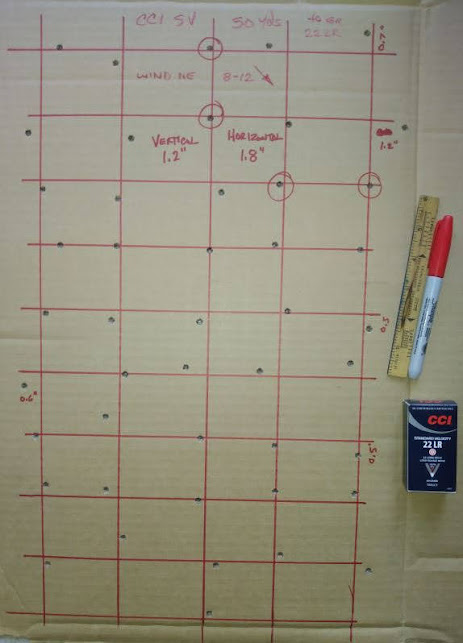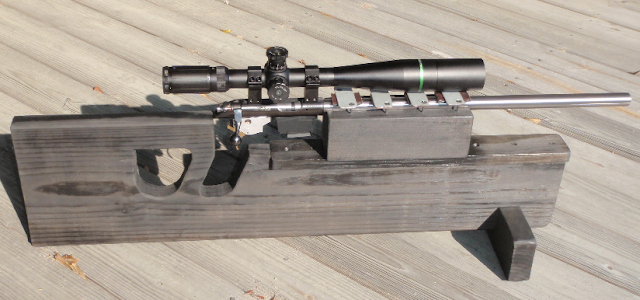I've spent the last three years shooting groups.
50 shots at a time, 100 and 200 yards and documenting the results.
I noticed something that annoys me, groups don't satisfy Rule #1....Hit what you aim at.
The group may be tight, but the center of the group wanders relative to the point of aim.
Shooting a group works well for dialing in a scope or checking ammunition quality,
but it doesn't meet the requirements of Rule #1.
Shooting for score is a much better method for evaluating accuracy.
But it sure does eat up ink and printer paper...that stuff is damn expensive.
Almost cheaper to buy a new printer each time the ink runs low.
I devised a much simpler solution for keeping track of my results, The Grid.
Section of cardboard, a straight edge and a marker, 5 lines horizontal, 10 vertical, try to punch the intersects.
Makes for a cheap and effective technique of documenting my results at 50 and 100 yards.
No proprietary targets, no printer paper or expensive ink consumed, the cardboard can be recycled.
Same effect as the USBR Green Monster X 2, all 50 shots on a single target.

Makes it very simple to document improvement over time, and ammo quality.
Not like groups where problems get hidden by the shift of the group due to wind or mv spread.
Cartridge created strays don't hide in the outer edges of the bug hole, every shot is on it's own.
Where it impacts is easily seen relative to the grid lines. Claims of sub-moa "all day long" don't hold up.
In order to maintain sub-moa at 50 yards, all bullet holes must show up less than 0.26 inch
from grid intersect to center of impact. At 100 yards have to stay within 0.52 inches.
That is not an easy thing to accomplish.
Tried it this weekend, CZ 455, Lilja barrel, 32x target scope on heavy bags, 50 yards.
Wind from the NE at 8-12 mph, my 10 o'clock.

Up first, CCI SV

Nope, no "all day long" there.
Then some Prime Semi-Auto, made by RWS.

Nope, those cartridges can't produce predictable trajectories.
MV spread and strays caused by cartridge problems.
Hey! Where's y'er wind flags? Those strays are caused by wind!
We don't need no stinking wind flags...it's fall. Fluff is in the air.
Seeds with the attached fluff are carried across the range, blown loose from the berm vegetation.
Extremely easy to see what the wind is up to. Watch the fluff dance up/down/left/right,
wait for it to drop and then squeeze. Nature's own wind-i-cators.

Jbell's 6x5 shows what happens for group size, but not how it does with Rule #1.
Grab some cardboard, draw those lines, let's see if you can really maintain sub-moa "all day long".
I can't, not with cheap rimfire ammunition. I'm going to try this with 22lr, 17hmr and 22wmr.
If you have a 17 hm2 or a 17 wsm, show us what you can accomplish. No printer ink or paper needed.
50 shots on one chunk of cardboard, no measuring or scoring needed. The bullets themselves tell the hole story.

50 shots at a time, 100 and 200 yards and documenting the results.
I noticed something that annoys me, groups don't satisfy Rule #1....Hit what you aim at.
The group may be tight, but the center of the group wanders relative to the point of aim.
Shooting a group works well for dialing in a scope or checking ammunition quality,
but it doesn't meet the requirements of Rule #1.
Shooting for score is a much better method for evaluating accuracy.
But it sure does eat up ink and printer paper...that stuff is damn expensive.
Almost cheaper to buy a new printer each time the ink runs low.
I devised a much simpler solution for keeping track of my results, The Grid.
Section of cardboard, a straight edge and a marker, 5 lines horizontal, 10 vertical, try to punch the intersects.
Makes for a cheap and effective technique of documenting my results at 50 and 100 yards.
No proprietary targets, no printer paper or expensive ink consumed, the cardboard can be recycled.
Same effect as the USBR Green Monster X 2, all 50 shots on a single target.
Makes it very simple to document improvement over time, and ammo quality.
Not like groups where problems get hidden by the shift of the group due to wind or mv spread.
Cartridge created strays don't hide in the outer edges of the bug hole, every shot is on it's own.
Where it impacts is easily seen relative to the grid lines. Claims of sub-moa "all day long" don't hold up.
In order to maintain sub-moa at 50 yards, all bullet holes must show up less than 0.26 inch
from grid intersect to center of impact. At 100 yards have to stay within 0.52 inches.
That is not an easy thing to accomplish.
Tried it this weekend, CZ 455, Lilja barrel, 32x target scope on heavy bags, 50 yards.
Wind from the NE at 8-12 mph, my 10 o'clock.
Up first, CCI SV
Nope, no "all day long" there.
Then some Prime Semi-Auto, made by RWS.
Nope, those cartridges can't produce predictable trajectories.
MV spread and strays caused by cartridge problems.
Hey! Where's y'er wind flags? Those strays are caused by wind!
We don't need no stinking wind flags...it's fall. Fluff is in the air.
Seeds with the attached fluff are carried across the range, blown loose from the berm vegetation.
Extremely easy to see what the wind is up to. Watch the fluff dance up/down/left/right,
wait for it to drop and then squeeze. Nature's own wind-i-cators.
Jbell's 6x5 shows what happens for group size, but not how it does with Rule #1.
Grab some cardboard, draw those lines, let's see if you can really maintain sub-moa "all day long".
I can't, not with cheap rimfire ammunition. I'm going to try this with 22lr, 17hmr and 22wmr.
If you have a 17 hm2 or a 17 wsm, show us what you can accomplish. No printer ink or paper needed.
50 shots on one chunk of cardboard, no measuring or scoring needed. The bullets themselves tell the hole story.
Last edited:












